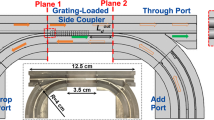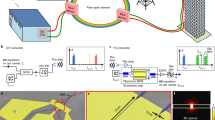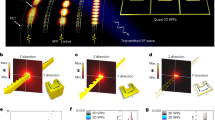Abstract
To cope with the high bandwidth requirements of wireless applications1, carrier frequencies are shifting towards the millimetre-wave and terahertz bands2,3,4,5. Conversely, data is normally transported to remote wireless antennas by optical fibres. Therefore, full transparency and flexibility to switch between optical and wireless domains would be desirable6,7. Here, we demonstrate a direct wireless-to-optical receiver in a transparent optical link. We successfully transmit 20 and 10 Gbit s−1 over wireless distances of 1 and 5 m, respectively, at a carrier frequency of 60 GHz. Key to the breakthrough is a plasmonic mixer directly mapping the wireless information onto optical signals. The plasmonic scheme with its subwavelength feature and pronounced field confinement provides a built-in field enhancement of up to 90,000 over the incident field in an ultra-compact and complementary metal-oxide–semiconductor compatible structure. The plasmonic mixer is not limited by electronic speed and thus compatible with future terahertz technologies.
This is a preview of subscription content, access via your institution
Access options
Access Nature and 54 other Nature Portfolio journals
Get Nature+, our best-value online-access subscription
$29.99 / 30 days
cancel any time
Subscribe to this journal
Receive 12 print issues and online access
$209.00 per year
only $17.42 per issue
Buy this article
- Purchase on Springer Link
- Instant access to full article PDF
Prices may be subject to local taxes which are calculated during checkout




Similar content being viewed by others

Data availability
The data that support the plots within this paper and other findings of this study are available from the corresponding author upon reasonable request.
Change history
07 November 2018
In the version of this Letter originally published online, the ORCID number, 0000-0002-8900-3237, of the author A. Josten was missing; and in Fig. 2b, in the y axis label, ‘×105’should have been ‘×103’. These errors have now been corrected in all versions.
References
Waterhouse, R. & Novak, D. Realizing 5G: microwave photonics for 5G mobile wireless systems. IEEE Microw. Mag. 16, 84–92 (2015).
Capmany, J. & Novak, D. Microwave photonics combines two worlds. Nat. Photon. 1, 319–330 (2007).
Yao, J. Microwave photonics. J. Lightw. Technol. 27, 314–335 (2009).
Nagatsuma, T., Ducournau, G. & Renaud, C. C. Advances in terahertz communications accelerated by photonics. Nat. Photon. 10, 371–379 (2016).
Seeds, A. J., Shams, H., Fice, M. J. & Renaud, C. C. Terahertz photonics for wireless communications. J. Lightw. Technol. 33, 579–587 (2015).
Lim, C. et al. Fiber-wireless networks and subsystem technologies. J. Lightw. Technol. 28, 390–405 (2010).
Shams, H. & Seeds, A. Photonics, fiber and THz wireless communication. Opt. Photon. News 28, 24–31 (2017).
Koenig, S. et al. Wireless sub-THz communication system with high data rate. Nat. Photon. 7, 977–981 (2013).
Ducournau, G. et al. Ultrawide-bandwidth single-channel 0.4-THz wireless link combining broadband quasi-optic photomixer and coherent detection. IEEE Trans. Terahertz Sci. Technol. 4, 328–337 (2014).
Yu, X. et al. 400-GHz wireless transmission of 60-Gb/s Nyquist-QPSK signals using UTC-PD and heterodyne mixer. IEEE Trans. Terahertz Sci. Technol. 6, 765–770 (2016).
Ito, H., Nakajima, F., Furuta, T. & Ishibashi, T. Continuous THz-wave generation using antenna-integrated uni-travelling-carrier photodiodes. Semicond. Sci. Technol. 20, S191 (2005).
Yardimci, N. T., Cakmakyapan, S., Hemmati, S. & Jarrahi, M. A high-power broadband terahertz source enabled by three-dimensional light confinement in a plasmonic nanocavity. Sci. Rep. 7, 4166 (2017).
Renaud, C. C. et al. Antenna integrated THz uni-traveling carrier photodiodes. IEEE J. Sel. Top. Quantum Electron. 24, 1–11 (2018).
Li, X., Yu, J., Xiao, J. & Xu, Y. Fiber-wireless-fiber link for 128-Gb/s PDM-16QAM signal transmission at W-band. IEEE Photon. Technol. Lett. 26, 1948–1951 (2014).
Marpaung, D. et al. Integrated microwave photonics. Laser Photon. Rev. 7, 506–538 (2013).
Yang, C., Li, X., Xiao, J., Chi, N. & Yu, J. Fiber‐wireless integration for 80 Gbps polarization division multiplexing—16QAM signal transmission at W‐band without RF down conversion. Microw. Opt. Technol. Lett 57, 9–13 (2015).
Wijayanto, Y. N., Murata, H. & Okamura, Y. Electrooptic millimeter-wave-lightwave signal converters suspended to gap-embedded patch antennas on low-k dielectric materials. IEEE J. Sel. Top. Quantum Electron. 19, 33–41 (2013).
Zhang, X. et al. Integrated photonic electromagnetic field sensor based on broadband bowtie antenna coupled silicon organic hybrid modulator. J. Lightw. Technol. 32, 3774–3784 (2014).
Park, D. et al. RF photonic downconversion of vector modulated signals based on a millimeter-wave coupled electrooptic nonlinear polymer phase-modulator. Opt. Express 25, 29885–29895 (2017).
Chung, C. J. et al. Silicon-based hybrid integrated photonic chip for Ku band electromagnetic wave sensing. J. Lightw. Technol. 36, 1568–1575 (2018).
Brongersma, M. L. & Shalaev, V. M. The case for plasmonics. Science 328, 440–441 (2010).
Hoessbacher, C. et al. Plasmonic modulator with >170 GHz bandwidth demonstrated at 100 GBd NRZ. Opt. Express 25, 1762–1768 (2017).
Baeuerle, B. et al. Driver-less sub 1Vpp operation of a plasmonic-organic hybrid modulator at 100 GBd NRZ. in Optical Fiber Communication Conference M2I.1 (Optical Society of America, 2018).
Gramotnev, D. K. & Bozhevolnyi, S. I. Plasmonics beyond the diffraction limit. Nat. Photon. 4, 83–91 (2010).
Benea-Chelmus, I.-C. et al. Three-dimensional phase modulator at telecom wavelength acting as a terahertz detector with an electro-optic bandwidth of 1.25 terahertz. ACS Photon. 5, 1398–1403 (2018).
Haffner, C. et al. Plasmonic organic hybrid modulators—scaling highest speed photonics to the microscale. Proc. IEEE 104, 2362–2379 (2016).
Salamin, Y. et al. Direct conversion of free space millimeter waves to optical domain by plasmonic modulator antenna. Nano. Lett. 15, 8342–8346 (2015).
Pile, D. F. P. et al. Two-dimensionally localized modes of a nanoscale gap plasmon waveguide. Appl. Phys. Lett. 87, 261114 (2005).
Elder, D. L. et al. Effect of rigid bridge-protection units, quadrupolar interactions, and blending in organic electro-optic chromophores. Chem. Mater. 29, 6457–6471 (2017).
Woo, I., Nguyen, T. K., Han, H., Lim, H. & Park, I. Four-leaf-clover-shaped antenna for a THz photomixer. Opt. Express 18, 18532–18542 (2010).
Heni, W. et al. Nonlinearities of organic electro-optic materials in nanoscale slots and implications for the optimum modulator design. Opt. Express 25, 2627–2653 (2017).
Mokhtari-Koushyar, F. et al. Wideband multi-arm bowtie antenna for millimeter wave electro-optic sensors and receivers. J. Lightw. Technol. 36, 3418–3426 (2018).
Chang, F., Onohara, K. & Mizuochi, T. Forward error correction for 100 G transport networks. IEEE Commun. Mag. 48, S48–S55 (2010).
Kallfass, I. et al. 64 Gbit/s transmission over 850 m fixed wireless link at 240 GHz carrier frequency. J. Infrared Millim. Terahertz Waves 36, 221–233 (2015).
Vermeulen, D. et al. High-efficiency fiber-to-chip grating couplers realized using an advanced CMOS-compatible silicon-on-insulator platform. Opt. Express 18, 18278–18283 (2010).
Haffner, C. et al. Low-loss plasmon-assisted electro-optic modulator. Nature 556, 483–486 (2018).
Ummethala, S. et al. Terahertz-to-optical conversion using a plasmonic modulator. in Conference on Lasers and Electro-Optics STu3D.4 (Optical Society of America, 2018).
Jia, S. et al. 120 Gb/s multi-channel THz wireless transmission and THz receiver performance analysis. IEEE Photon. Technol. Lett. 29, 310–313 (2017).
Sun, J., Timurdogan, E., Yaacobi, A., Hosseini, E. S. & Watts, M. R. Large-scale nanophotonic phased array. Nature 493, 195–199 (2013).
Haffner, C. et al. All-plasmonic Mach–Zehnder modulator enabling optical high-speed communication at the microscale. Nat. Photon. 9, 525–528 (2015).
Tian, J., Yu, S., Yan, W. & Qiu, M. Broadband high-efficiency surface-plasmon-polariton coupler with silicon-metal interface. Appl. Phys. Lett. 95, 13504 (2009).
Acknowledgements
This work was carried out partially at the Binnig and Rohrer Nanotechnology Center (BRNC) and in the FIRST lab cleanroom facility at ETH Zurich. We are grateful to H. R. Benedickter and U. Drechsler for the help in the measurement and fabrication, respectively. The European Union project ERC PLASILOR (670478) and PLASMOfab (688166) are acknowledged for partial funding of the work. The US National Science Foundation (DMR-1303080) and the Air Force Office of Scientific Research (FA9550-15-1-0319). The ETH Postdoctoral Fellowship (16-2-FEL-51). M.B. acknowledges the SNSF Ambizione grant (173996).
Author information
Authors and Affiliations
Contributions
Y.S conceived the concept, designed and fabricated the device, designed and performed the experiments and analysed the data. B.B., F.C.A. and A.J. performed the data experiment and data analysis. W.H. fabricated the device, developed the poling process and contributed to the measurements. Y.F. fabricated the device. C.H. contributed to the design of the device and experiment. R.B. and M.B. contributed to the design of the experiment. T.W contributed to the design of the device. D.L.E. and L.R.D. developed and synthesized the HD-BB-OH/YLD124 nonlinear material. J.L. conceived the concept and supervised the project. All authors have contributed to the writing of the manuscript.
Corresponding authors
Ethics declarations
Competing interests
The authors declare no competing interests.
Additional information
Publisher’s note: Springer Nature remains neutral with regard to jurisdictional claims in published maps and institutional affiliations.
Supplementary information
Supplementary Information
Discussion of the plasmonic phase modulator, field enhancement and experimental set-up
Rights and permissions
About this article
Cite this article
Salamin, Y., Baeuerle, B., Heni, W. et al. Microwave plasmonic mixer in a transparent fibre–wireless link. Nature Photon 12, 749–753 (2018). https://doi.org/10.1038/s41566-018-0281-6
Received:
Accepted:
Published:
Issue Date:
DOI: https://doi.org/10.1038/s41566-018-0281-6
This article is cited by
-
Plasmonic Slot Waveguide Propagation Analysis
Plasmonics (2023)
-
A metasurface-based light-to-microwave transmitter for hybrid wireless communications
Light: Science & Applications (2022)
-
Focusing the electromagnetic field to 10−6λ for ultra-high enhancement of field-matter interaction
Nature Communications (2021)
-
Nanoscale nonlinear plasmonics in photonic waveguides and circuits
La Rivista del Nuovo Cimento (2021)
-
An optically driven digital metasurface for programming electromagnetic functions
Nature Electronics (2020)


